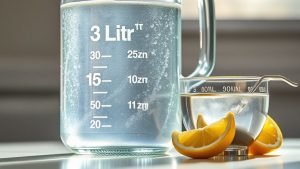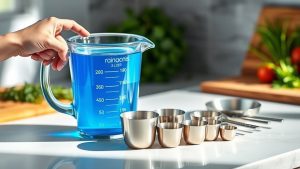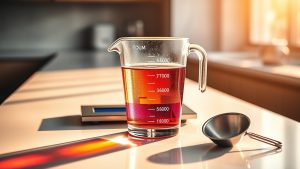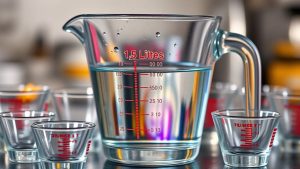
To convert liters to ounces in three easy steps, first identify the number of liters you're measuring. Second, multiply that number by 33.814 for fluid ounces. If you need weight ounces, use the formula: ounces = liters × 35.274 × density (in g/mL). For water, the density is roughly 1 g/mL, making calculations straightforward. Want to learn more about maximizing your conversions? Stay with us for tips and insights!
Converting liters to ounces can seem challenging, but it's actually quite straightforward. You just need to grasp the difference between fluid ounces and weight ounces. Fluid ounces are used for measuring volume, while weight ounces are used for mass. Depending on what you're converting, you might need to take into account the density of the substance. For example, if you're converting for cooking or mixing drinks, you'll primarily deal with fluid ounces. But if you're weighing something, you'll want to pay attention to density.
To start your conversion, know that 1 liter is approximately equal to 33.814 fluid ounces. This is your go-to conversion factor for straightforward volume conversions. If you're converting liters to fluid ounces, simply multiply the number of liters by 33.814. For instance, if you have 2 liters, the calculation would be 2 × 33.814, which equals about 67.628 fluid ounces. It's a simple arithmetic operation, and you're done! Just remember to use this factor only for fluid ounces.
1 liter equals approximately 33.814 fluid ounces; simply multiply liters by this factor for quick conversions.
However, if you're looking to convert liters to weight ounces, you'll need to factor in the density of the substance you're measuring. Density is usually expressed in grams per milliliter (g/mL) or another mass per volume unit. For example, water has a density of approximately 1 g/mL, so you can use that density for your calculations. The formula for weight ounces is a bit different: ounces = liters × 35.274 × density (in g/mL). If you're converting 2 liters of water, using the density, your calculation would look like this: 2 × 35.274 × 1, which equals 70.548 ounces. Density in grams per milliliter (g/mL) can be converted to oz/L by multiplying by 35.274.
Accuracy is key when performing these conversions, especially in recipes or scientific experiments. A small error can lead to significant differences in results. Always double-check your calculations, and if you're using density, verify you're using the correct value for the substance you're measuring. Additionally, rounding should be done carefully. Avoid rounding too early in your calculations, as this can lead to cumulative errors that affect the final result.
If you're ever unsure, conversion tables and online calculators can be lifesavers. They provide quick references without needing to perform any calculations yourself. You can find these tools on various websites, which makes it easy to convert liters to ounces in just a few clicks. Additionally, density tables are handy for finding the densities of various liquids, which can simplify your weight conversions.
In the end, whether you're cooking, measuring for a fitness regimen, or conducting a scientific experiment, understanding how to convert liters to ounces accurately will serve you well. Just remember the difference between fluid ounces and weight ounces and factor in density when necessary. With practice, these conversions will become second nature, and you'll find yourself mastering measurements with ease.
Conclusion
Now that you've mastered the art of converting liters to ounces, think of it as opening a treasure chest of measurements. Each ounce is a shimmering gem that helps you navigate recipes or beverages with ease. Whether you're pouring a revitalizing drink or whipping up a delicious meal, you've got the tools to guarantee precision. So, go ahead and let your newfound skill shine brightly, turning every cooking or mixing adventure into a delightful success!



